Corporate Regulation, Accounting Standards, and Owners Equity
VerifiedAdded on 2023/06/05
|17
|3626
|286
Report
AI Summary
This report delves into the intricacies of corporate regulation and accounting standards, particularly focusing on their impact on owner's equity. It examines the role of regulatory bodies like the IASB and AASB, highlighting the importance of financial reporting standards. The report further analyzes the owner's equity components of four publicly traded Australian companies—Bapcor Limited, Harvey Norman Holdings Limited, Nick Scali Limited, and The Pas Group Limited—assessing their contributed equity, reserves, and retained earnings over a four-year period. A comparative analysis of these companies' debt-equity positions is also presented, providing a comprehensive overview of their financial structures and regulatory compliance.
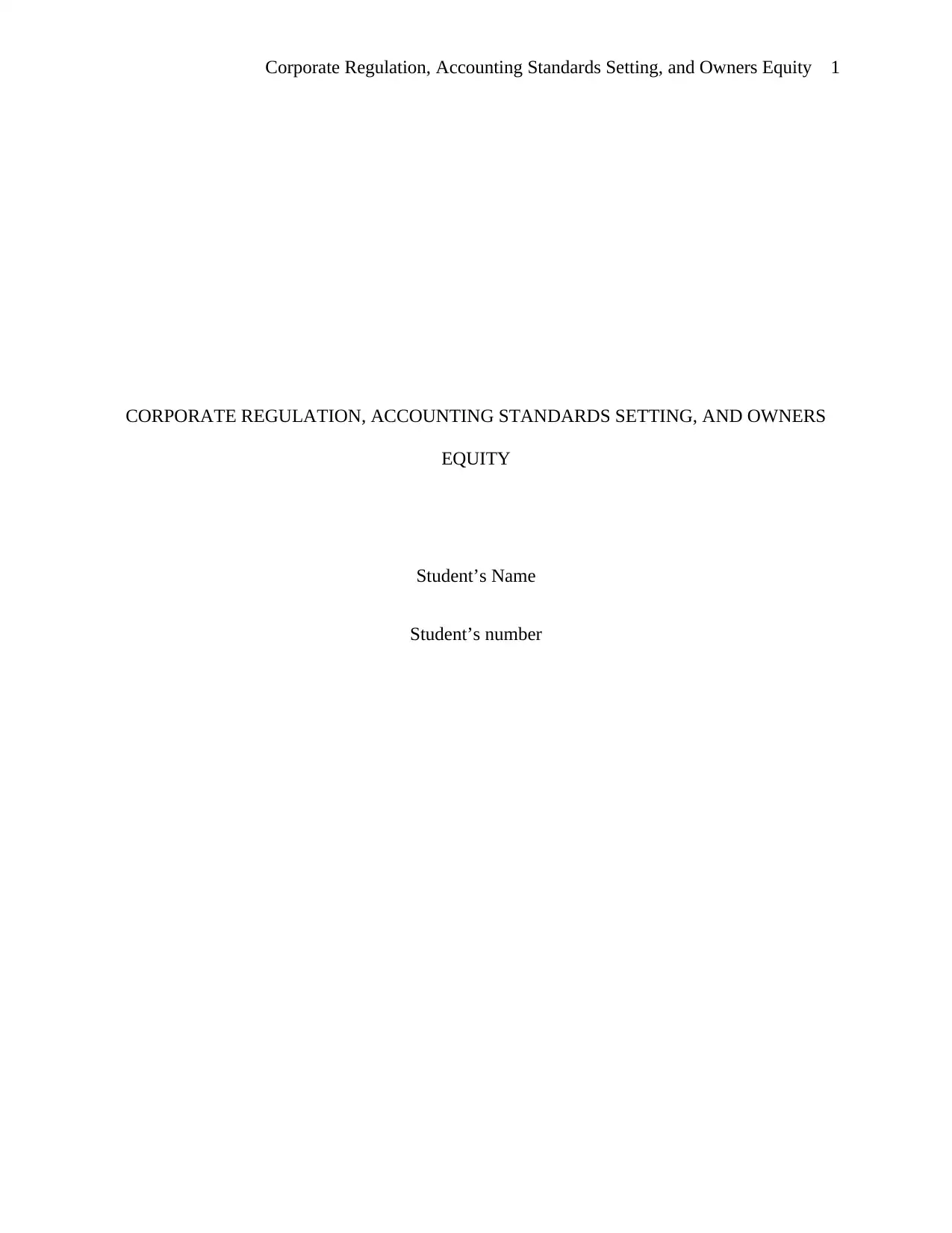
Corporate Regulation, Accounting Standards Setting, and Owners Equity 1
CORPORATE REGULATION, ACCOUNTING STANDARDS SETTING, AND OWNERS
EQUITY
Student’s Name
Student’s number
CORPORATE REGULATION, ACCOUNTING STANDARDS SETTING, AND OWNERS
EQUITY
Student’s Name
Student’s number
Paraphrase This Document
Need a fresh take? Get an instant paraphrase of this document with our AI Paraphraser
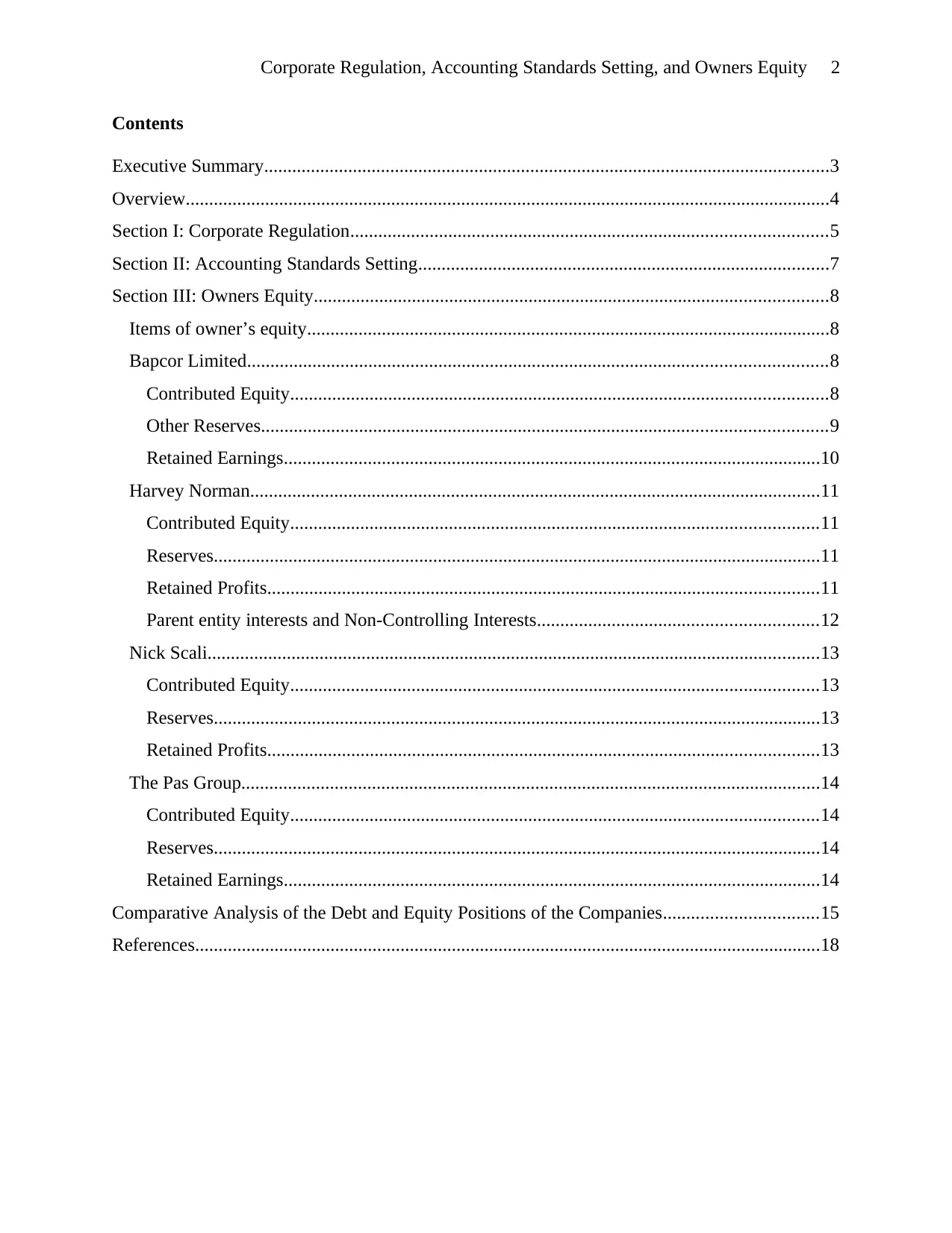
Corporate Regulation, Accounting Standards Setting, and Owners Equity 2
Contents
Executive Summary.........................................................................................................................3
Overview..........................................................................................................................................4
Section I: Corporate Regulation......................................................................................................5
Section II: Accounting Standards Setting........................................................................................7
Section III: Owners Equity..............................................................................................................8
Items of owner’s equity................................................................................................................8
Bapcor Limited............................................................................................................................8
Contributed Equity...................................................................................................................8
Other Reserves.........................................................................................................................9
Retained Earnings...................................................................................................................10
Harvey Norman..........................................................................................................................11
Contributed Equity.................................................................................................................11
Reserves..................................................................................................................................11
Retained Profits......................................................................................................................11
Parent entity interests and Non-Controlling Interests............................................................12
Nick Scali...................................................................................................................................13
Contributed Equity.................................................................................................................13
Reserves..................................................................................................................................13
Retained Profits......................................................................................................................13
The Pas Group............................................................................................................................14
Contributed Equity.................................................................................................................14
Reserves..................................................................................................................................14
Retained Earnings...................................................................................................................14
Comparative Analysis of the Debt and Equity Positions of the Companies.................................15
References......................................................................................................................................18
Contents
Executive Summary.........................................................................................................................3
Overview..........................................................................................................................................4
Section I: Corporate Regulation......................................................................................................5
Section II: Accounting Standards Setting........................................................................................7
Section III: Owners Equity..............................................................................................................8
Items of owner’s equity................................................................................................................8
Bapcor Limited............................................................................................................................8
Contributed Equity...................................................................................................................8
Other Reserves.........................................................................................................................9
Retained Earnings...................................................................................................................10
Harvey Norman..........................................................................................................................11
Contributed Equity.................................................................................................................11
Reserves..................................................................................................................................11
Retained Profits......................................................................................................................11
Parent entity interests and Non-Controlling Interests............................................................12
Nick Scali...................................................................................................................................13
Contributed Equity.................................................................................................................13
Reserves..................................................................................................................................13
Retained Profits......................................................................................................................13
The Pas Group............................................................................................................................14
Contributed Equity.................................................................................................................14
Reserves..................................................................................................................................14
Retained Earnings...................................................................................................................14
Comparative Analysis of the Debt and Equity Positions of the Companies.................................15
References......................................................................................................................................18
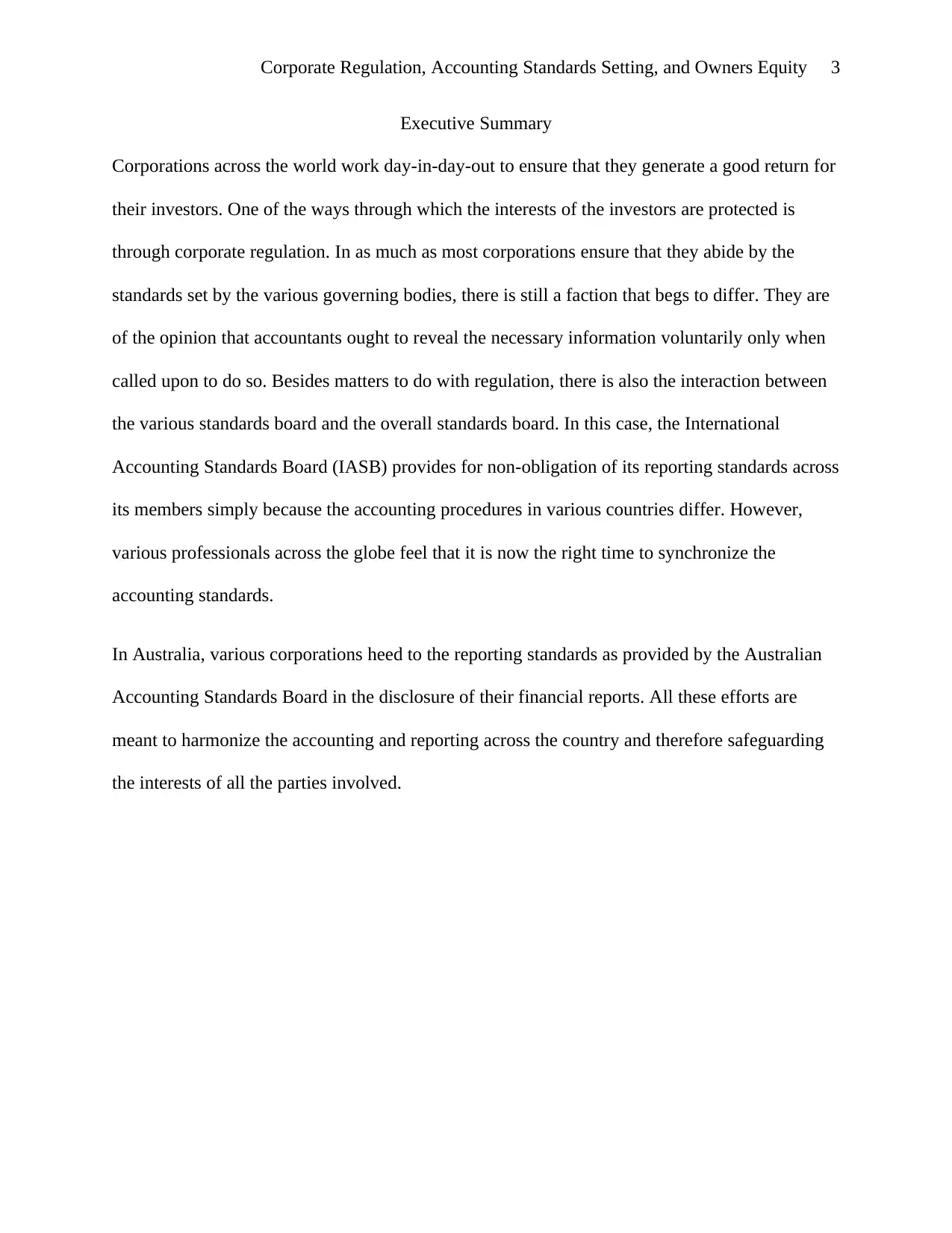
Corporate Regulation, Accounting Standards Setting, and Owners Equity 3
Executive Summary
Corporations across the world work day-in-day-out to ensure that they generate a good return for
their investors. One of the ways through which the interests of the investors are protected is
through corporate regulation. In as much as most corporations ensure that they abide by the
standards set by the various governing bodies, there is still a faction that begs to differ. They are
of the opinion that accountants ought to reveal the necessary information voluntarily only when
called upon to do so. Besides matters to do with regulation, there is also the interaction between
the various standards board and the overall standards board. In this case, the International
Accounting Standards Board (IASB) provides for non-obligation of its reporting standards across
its members simply because the accounting procedures in various countries differ. However,
various professionals across the globe feel that it is now the right time to synchronize the
accounting standards.
In Australia, various corporations heed to the reporting standards as provided by the Australian
Accounting Standards Board in the disclosure of their financial reports. All these efforts are
meant to harmonize the accounting and reporting across the country and therefore safeguarding
the interests of all the parties involved.
Executive Summary
Corporations across the world work day-in-day-out to ensure that they generate a good return for
their investors. One of the ways through which the interests of the investors are protected is
through corporate regulation. In as much as most corporations ensure that they abide by the
standards set by the various governing bodies, there is still a faction that begs to differ. They are
of the opinion that accountants ought to reveal the necessary information voluntarily only when
called upon to do so. Besides matters to do with regulation, there is also the interaction between
the various standards board and the overall standards board. In this case, the International
Accounting Standards Board (IASB) provides for non-obligation of its reporting standards across
its members simply because the accounting procedures in various countries differ. However,
various professionals across the globe feel that it is now the right time to synchronize the
accounting standards.
In Australia, various corporations heed to the reporting standards as provided by the Australian
Accounting Standards Board in the disclosure of their financial reports. All these efforts are
meant to harmonize the accounting and reporting across the country and therefore safeguarding
the interests of all the parties involved.
⊘ This is a preview!⊘
Do you want full access?
Subscribe today to unlock all pages.

Trusted by 1+ million students worldwide
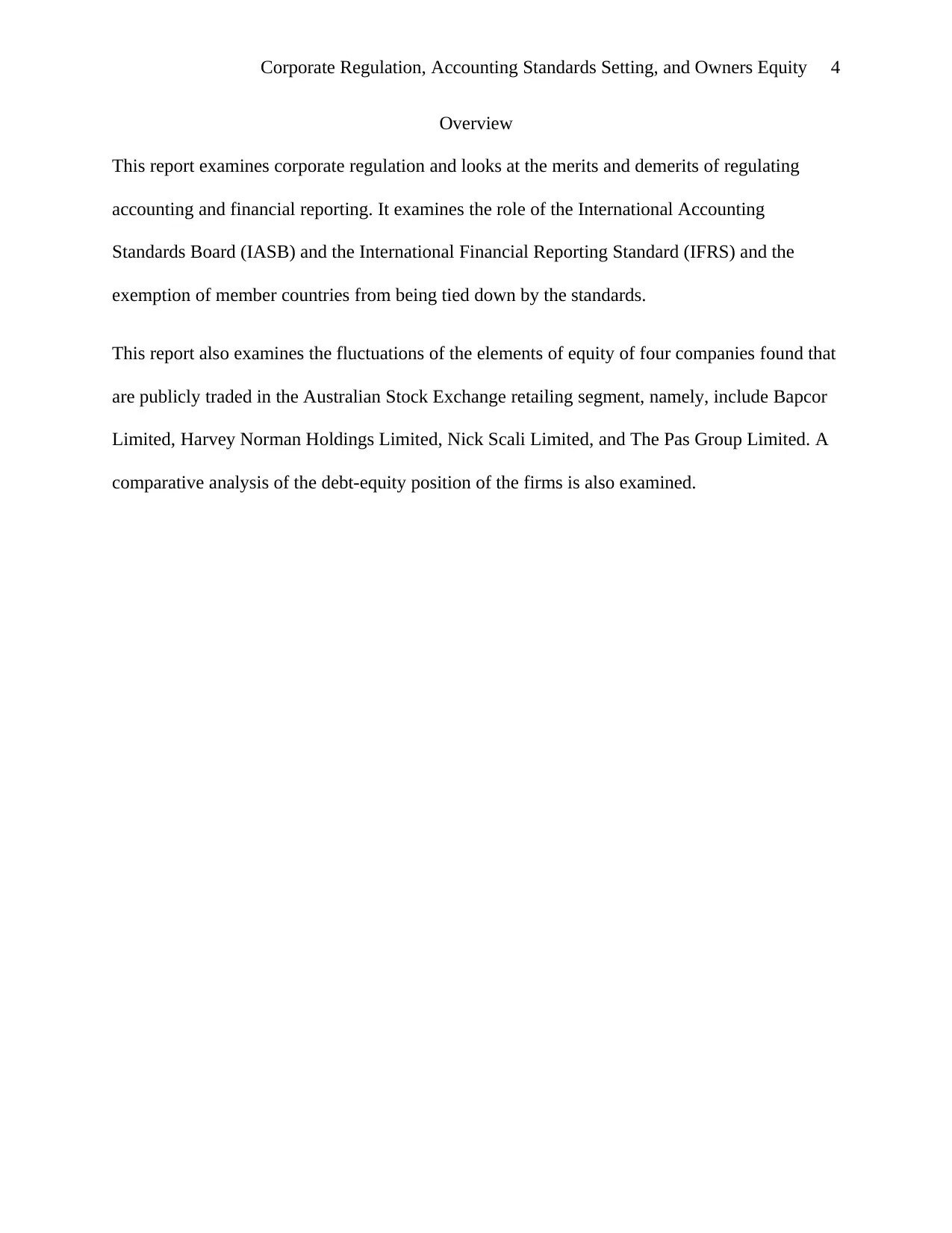
Corporate Regulation, Accounting Standards Setting, and Owners Equity 4
Overview
This report examines corporate regulation and looks at the merits and demerits of regulating
accounting and financial reporting. It examines the role of the International Accounting
Standards Board (IASB) and the International Financial Reporting Standard (IFRS) and the
exemption of member countries from being tied down by the standards.
This report also examines the fluctuations of the elements of equity of four companies found that
are publicly traded in the Australian Stock Exchange retailing segment, namely, include Bapcor
Limited, Harvey Norman Holdings Limited, Nick Scali Limited, and The Pas Group Limited. A
comparative analysis of the debt-equity position of the firms is also examined.
Overview
This report examines corporate regulation and looks at the merits and demerits of regulating
accounting and financial reporting. It examines the role of the International Accounting
Standards Board (IASB) and the International Financial Reporting Standard (IFRS) and the
exemption of member countries from being tied down by the standards.
This report also examines the fluctuations of the elements of equity of four companies found that
are publicly traded in the Australian Stock Exchange retailing segment, namely, include Bapcor
Limited, Harvey Norman Holdings Limited, Nick Scali Limited, and The Pas Group Limited. A
comparative analysis of the debt-equity position of the firms is also examined.
Paraphrase This Document
Need a fresh take? Get an instant paraphrase of this document with our AI Paraphraser
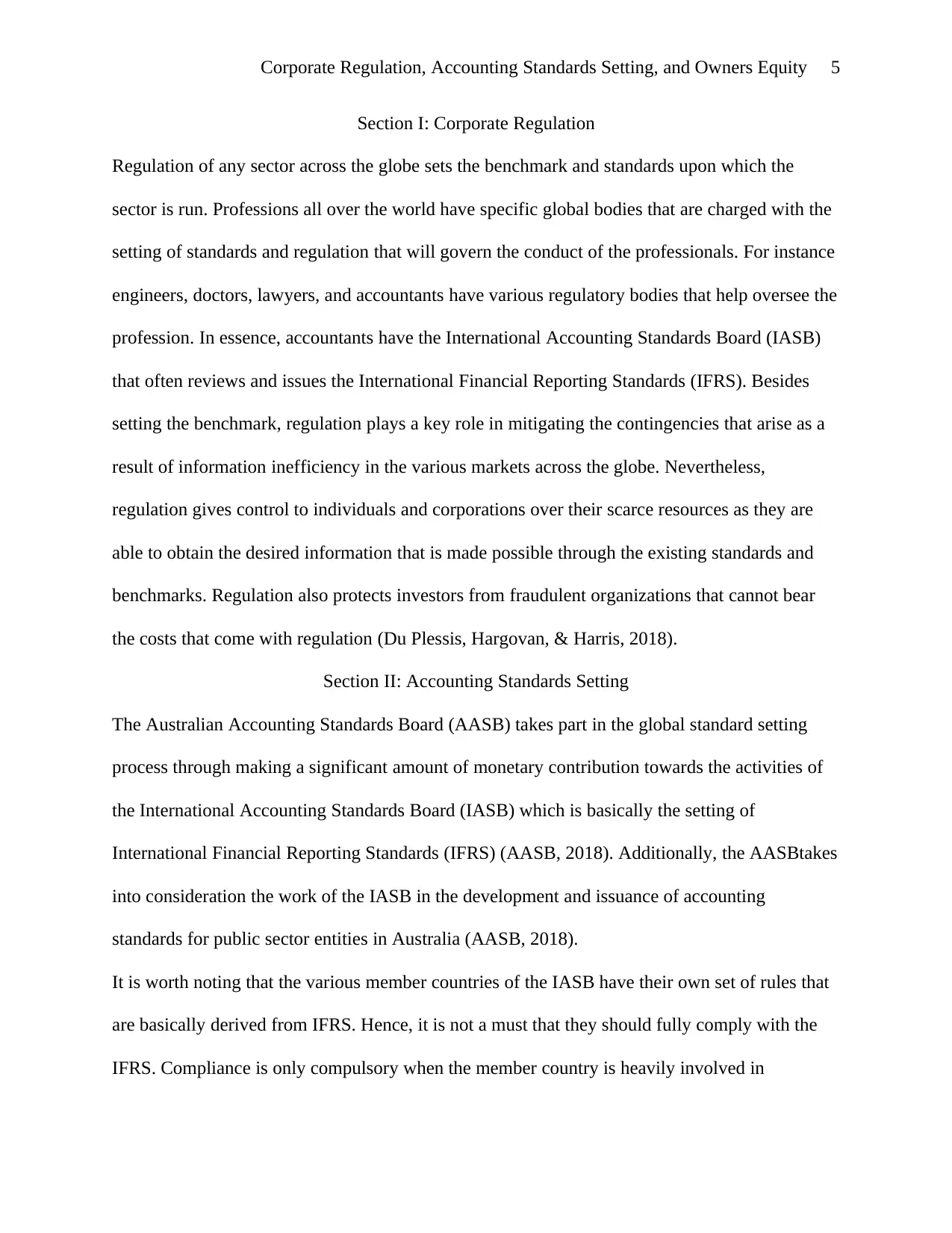
Corporate Regulation, Accounting Standards Setting, and Owners Equity 5
Section I: Corporate Regulation
Regulation of any sector across the globe sets the benchmark and standards upon which the
sector is run. Professions all over the world have specific global bodies that are charged with the
setting of standards and regulation that will govern the conduct of the professionals. For instance
engineers, doctors, lawyers, and accountants have various regulatory bodies that help oversee the
profession. In essence, accountants have the International Accounting Standards Board (IASB)
that often reviews and issues the International Financial Reporting Standards (IFRS). Besides
setting the benchmark, regulation plays a key role in mitigating the contingencies that arise as a
result of information inefficiency in the various markets across the globe. Nevertheless,
regulation gives control to individuals and corporations over their scarce resources as they are
able to obtain the desired information that is made possible through the existing standards and
benchmarks. Regulation also protects investors from fraudulent organizations that cannot bear
the costs that come with regulation (Du Plessis, Hargovan, & Harris, 2018).
Section II: Accounting Standards Setting
The Australian Accounting Standards Board (AASB) takes part in the global standard setting
process through making a significant amount of monetary contribution towards the activities of
the International Accounting Standards Board (IASB) which is basically the setting of
International Financial Reporting Standards (IFRS) (AASB, 2018). Additionally, the AASBtakes
into consideration the work of the IASB in the development and issuance of accounting
standards for public sector entities in Australia (AASB, 2018).
It is worth noting that the various member countries of the IASB have their own set of rules that
are basically derived from IFRS. Hence, it is not a must that they should fully comply with the
IFRS. Compliance is only compulsory when the member country is heavily involved in
Section I: Corporate Regulation
Regulation of any sector across the globe sets the benchmark and standards upon which the
sector is run. Professions all over the world have specific global bodies that are charged with the
setting of standards and regulation that will govern the conduct of the professionals. For instance
engineers, doctors, lawyers, and accountants have various regulatory bodies that help oversee the
profession. In essence, accountants have the International Accounting Standards Board (IASB)
that often reviews and issues the International Financial Reporting Standards (IFRS). Besides
setting the benchmark, regulation plays a key role in mitigating the contingencies that arise as a
result of information inefficiency in the various markets across the globe. Nevertheless,
regulation gives control to individuals and corporations over their scarce resources as they are
able to obtain the desired information that is made possible through the existing standards and
benchmarks. Regulation also protects investors from fraudulent organizations that cannot bear
the costs that come with regulation (Du Plessis, Hargovan, & Harris, 2018).
Section II: Accounting Standards Setting
The Australian Accounting Standards Board (AASB) takes part in the global standard setting
process through making a significant amount of monetary contribution towards the activities of
the International Accounting Standards Board (IASB) which is basically the setting of
International Financial Reporting Standards (IFRS) (AASB, 2018). Additionally, the AASBtakes
into consideration the work of the IASB in the development and issuance of accounting
standards for public sector entities in Australia (AASB, 2018).
It is worth noting that the various member countries of the IASB have their own set of rules that
are basically derived from IFRS. Hence, it is not a must that they should fully comply with the
IFRS. Compliance is only compulsory when the member country is heavily involved in
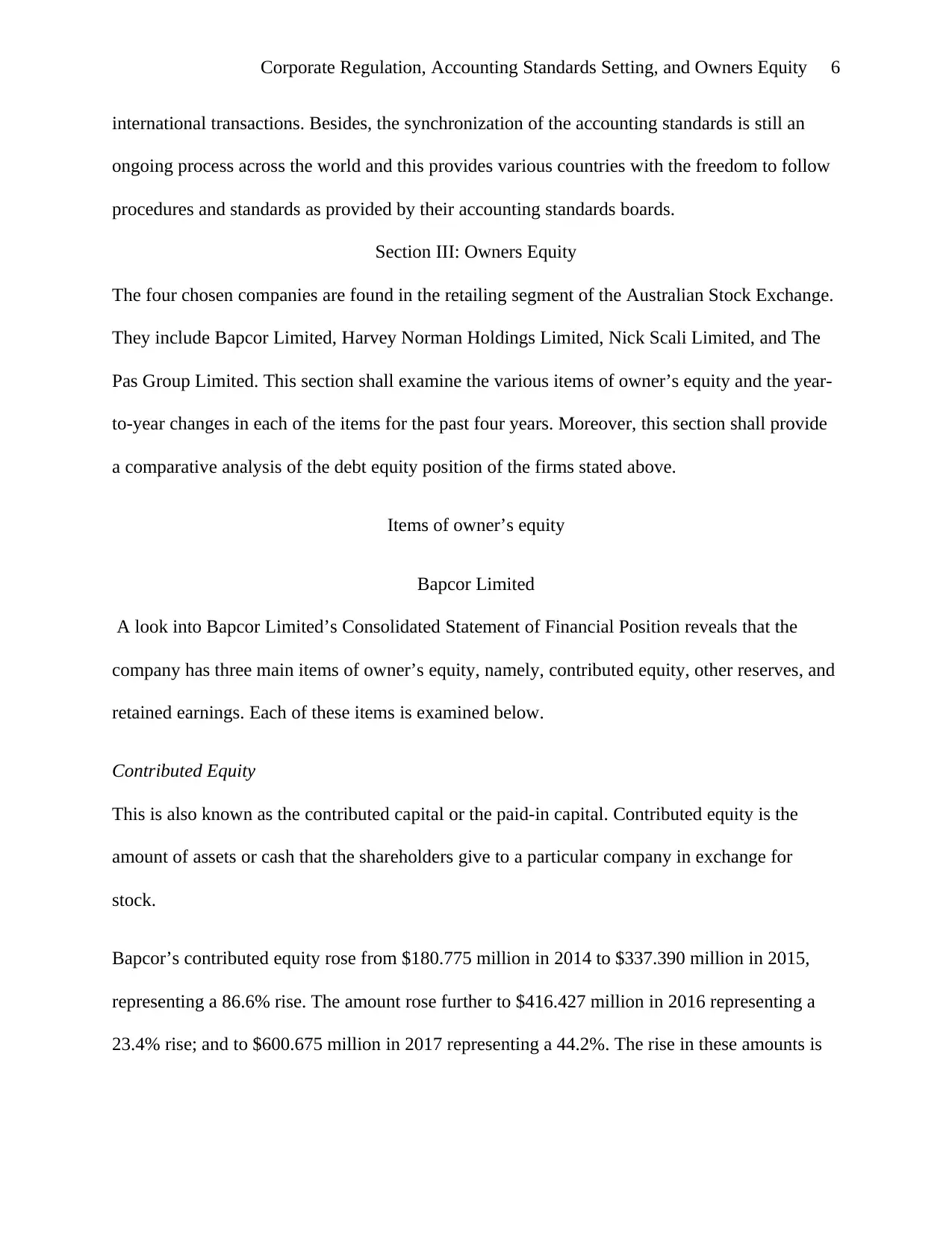
Corporate Regulation, Accounting Standards Setting, and Owners Equity 6
international transactions. Besides, the synchronization of the accounting standards is still an
ongoing process across the world and this provides various countries with the freedom to follow
procedures and standards as provided by their accounting standards boards.
Section III: Owners Equity
The four chosen companies are found in the retailing segment of the Australian Stock Exchange.
They include Bapcor Limited, Harvey Norman Holdings Limited, Nick Scali Limited, and The
Pas Group Limited. This section shall examine the various items of owner’s equity and the year-
to-year changes in each of the items for the past four years. Moreover, this section shall provide
a comparative analysis of the debt equity position of the firms stated above.
Items of owner’s equity
Bapcor Limited
A look into Bapcor Limited’s Consolidated Statement of Financial Position reveals that the
company has three main items of owner’s equity, namely, contributed equity, other reserves, and
retained earnings. Each of these items is examined below.
Contributed Equity
This is also known as the contributed capital or the paid-in capital. Contributed equity is the
amount of assets or cash that the shareholders give to a particular company in exchange for
stock.
Bapcor’s contributed equity rose from $180.775 million in 2014 to $337.390 million in 2015,
representing a 86.6% rise. The amount rose further to $416.427 million in 2016 representing a
23.4% rise; and to $600.675 million in 2017 representing a 44.2%. The rise in these amounts is
international transactions. Besides, the synchronization of the accounting standards is still an
ongoing process across the world and this provides various countries with the freedom to follow
procedures and standards as provided by their accounting standards boards.
Section III: Owners Equity
The four chosen companies are found in the retailing segment of the Australian Stock Exchange.
They include Bapcor Limited, Harvey Norman Holdings Limited, Nick Scali Limited, and The
Pas Group Limited. This section shall examine the various items of owner’s equity and the year-
to-year changes in each of the items for the past four years. Moreover, this section shall provide
a comparative analysis of the debt equity position of the firms stated above.
Items of owner’s equity
Bapcor Limited
A look into Bapcor Limited’s Consolidated Statement of Financial Position reveals that the
company has three main items of owner’s equity, namely, contributed equity, other reserves, and
retained earnings. Each of these items is examined below.
Contributed Equity
This is also known as the contributed capital or the paid-in capital. Contributed equity is the
amount of assets or cash that the shareholders give to a particular company in exchange for
stock.
Bapcor’s contributed equity rose from $180.775 million in 2014 to $337.390 million in 2015,
representing a 86.6% rise. The amount rose further to $416.427 million in 2016 representing a
23.4% rise; and to $600.675 million in 2017 representing a 44.2%. The rise in these amounts is
⊘ This is a preview!⊘
Do you want full access?
Subscribe today to unlock all pages.

Trusted by 1+ million students worldwide
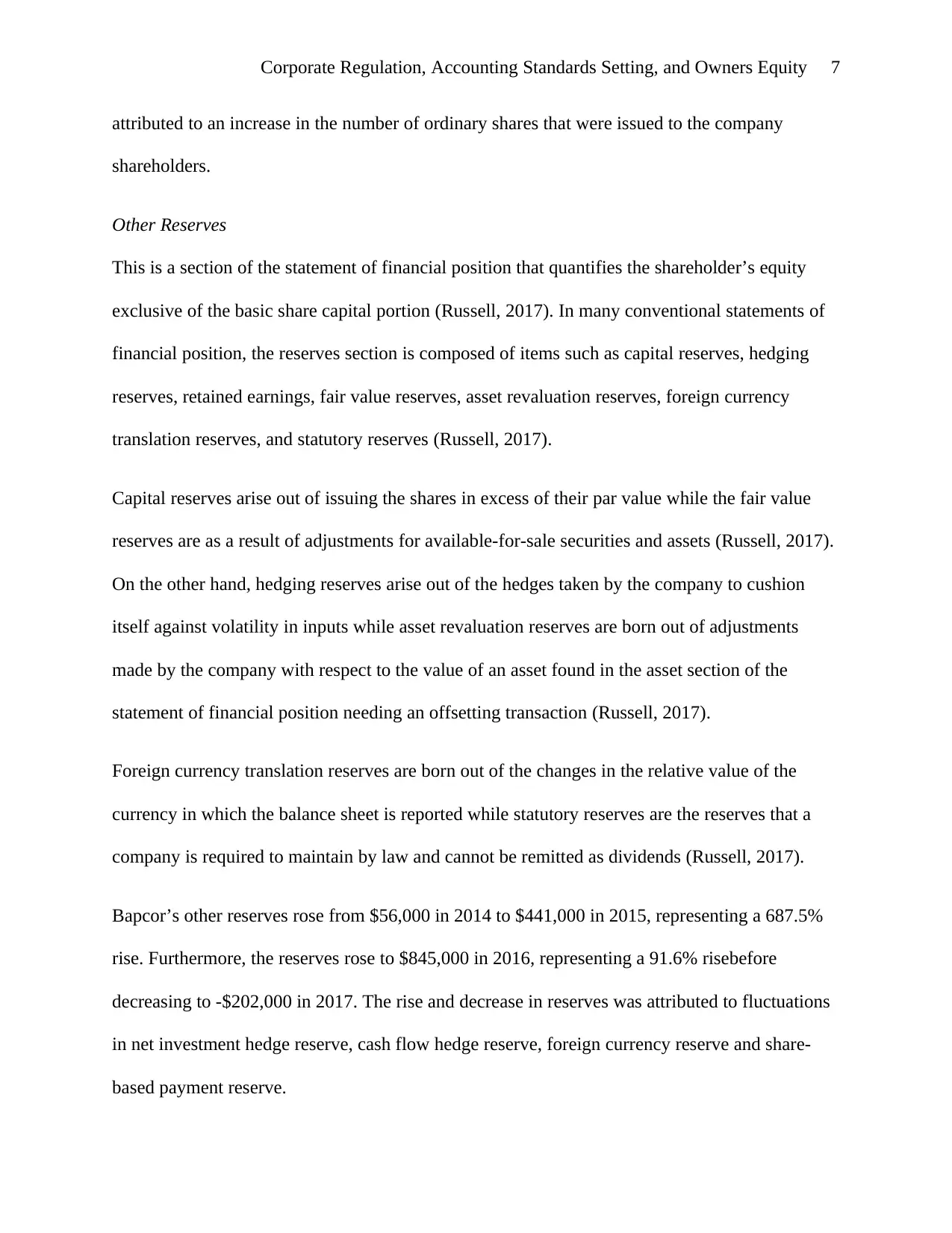
Corporate Regulation, Accounting Standards Setting, and Owners Equity 7
attributed to an increase in the number of ordinary shares that were issued to the company
shareholders.
Other Reserves
This is a section of the statement of financial position that quantifies the shareholder’s equity
exclusive of the basic share capital portion (Russell, 2017). In many conventional statements of
financial position, the reserves section is composed of items such as capital reserves, hedging
reserves, retained earnings, fair value reserves, asset revaluation reserves, foreign currency
translation reserves, and statutory reserves (Russell, 2017).
Capital reserves arise out of issuing the shares in excess of their par value while the fair value
reserves are as a result of adjustments for available-for-sale securities and assets (Russell, 2017).
On the other hand, hedging reserves arise out of the hedges taken by the company to cushion
itself against volatility in inputs while asset revaluation reserves are born out of adjustments
made by the company with respect to the value of an asset found in the asset section of the
statement of financial position needing an offsetting transaction (Russell, 2017).
Foreign currency translation reserves are born out of the changes in the relative value of the
currency in which the balance sheet is reported while statutory reserves are the reserves that a
company is required to maintain by law and cannot be remitted as dividends (Russell, 2017).
Bapcor’s other reserves rose from $56,000 in 2014 to $441,000 in 2015, representing a 687.5%
rise. Furthermore, the reserves rose to $845,000 in 2016, representing a 91.6% risebefore
decreasing to -$202,000 in 2017. The rise and decrease in reserves was attributed to fluctuations
in net investment hedge reserve, cash flow hedge reserve, foreign currency reserve and share-
based payment reserve.
attributed to an increase in the number of ordinary shares that were issued to the company
shareholders.
Other Reserves
This is a section of the statement of financial position that quantifies the shareholder’s equity
exclusive of the basic share capital portion (Russell, 2017). In many conventional statements of
financial position, the reserves section is composed of items such as capital reserves, hedging
reserves, retained earnings, fair value reserves, asset revaluation reserves, foreign currency
translation reserves, and statutory reserves (Russell, 2017).
Capital reserves arise out of issuing the shares in excess of their par value while the fair value
reserves are as a result of adjustments for available-for-sale securities and assets (Russell, 2017).
On the other hand, hedging reserves arise out of the hedges taken by the company to cushion
itself against volatility in inputs while asset revaluation reserves are born out of adjustments
made by the company with respect to the value of an asset found in the asset section of the
statement of financial position needing an offsetting transaction (Russell, 2017).
Foreign currency translation reserves are born out of the changes in the relative value of the
currency in which the balance sheet is reported while statutory reserves are the reserves that a
company is required to maintain by law and cannot be remitted as dividends (Russell, 2017).
Bapcor’s other reserves rose from $56,000 in 2014 to $441,000 in 2015, representing a 687.5%
rise. Furthermore, the reserves rose to $845,000 in 2016, representing a 91.6% risebefore
decreasing to -$202,000 in 2017. The rise and decrease in reserves was attributed to fluctuations
in net investment hedge reserve, cash flow hedge reserve, foreign currency reserve and share-
based payment reserve.
Paraphrase This Document
Need a fresh take? Get an instant paraphrase of this document with our AI Paraphraser
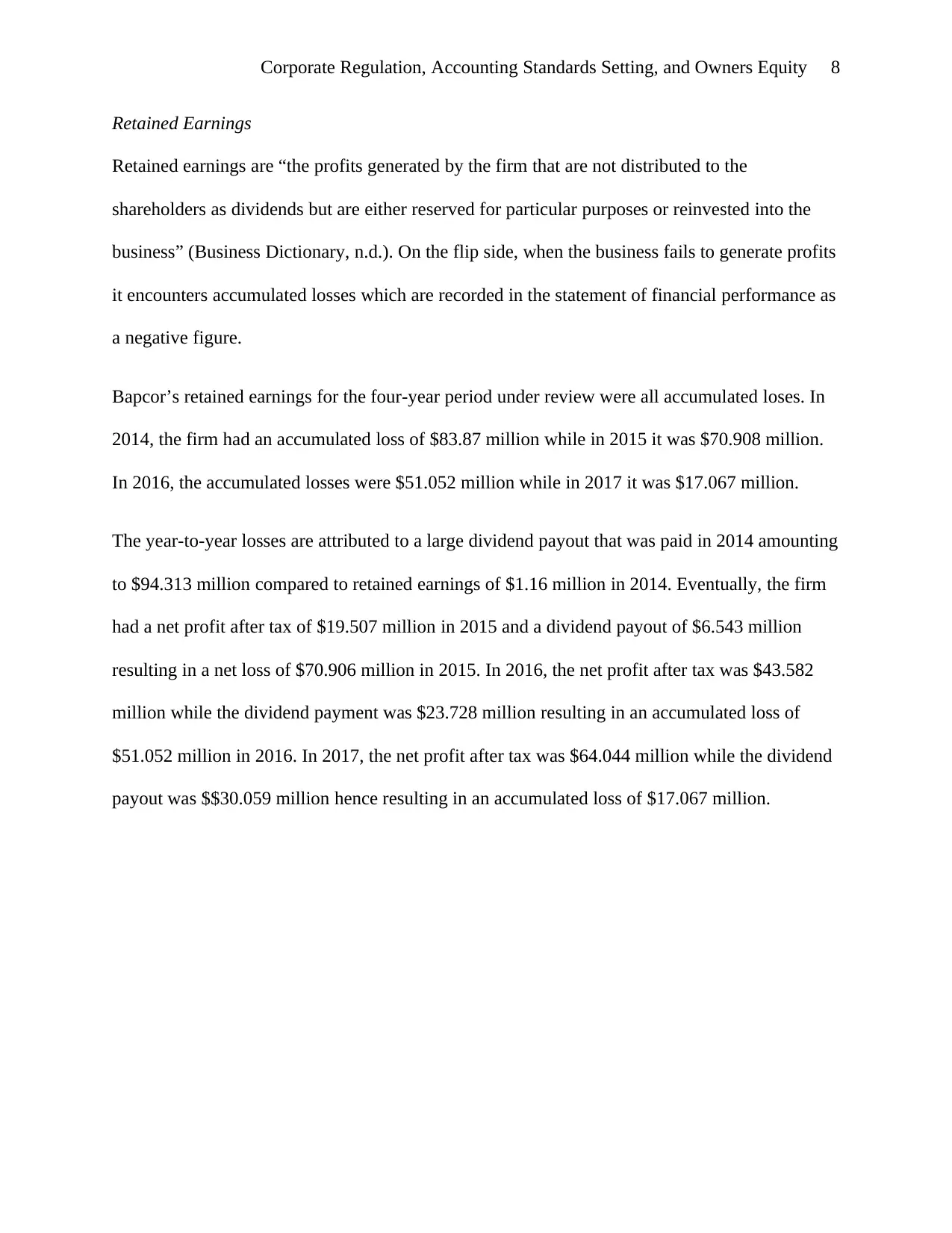
Corporate Regulation, Accounting Standards Setting, and Owners Equity 8
Retained Earnings
Retained earnings are “the profits generated by the firm that are not distributed to the
shareholders as dividends but are either reserved for particular purposes or reinvested into the
business” (Business Dictionary, n.d.). On the flip side, when the business fails to generate profits
it encounters accumulated losses which are recorded in the statement of financial performance as
a negative figure.
Bapcor’s retained earnings for the four-year period under review were all accumulated loses. In
2014, the firm had an accumulated loss of $83.87 million while in 2015 it was $70.908 million.
In 2016, the accumulated losses were $51.052 million while in 2017 it was $17.067 million.
The year-to-year losses are attributed to a large dividend payout that was paid in 2014 amounting
to $94.313 million compared to retained earnings of $1.16 million in 2014. Eventually, the firm
had a net profit after tax of $19.507 million in 2015 and a dividend payout of $6.543 million
resulting in a net loss of $70.906 million in 2015. In 2016, the net profit after tax was $43.582
million while the dividend payment was $23.728 million resulting in an accumulated loss of
$51.052 million in 2016. In 2017, the net profit after tax was $64.044 million while the dividend
payout was $$30.059 million hence resulting in an accumulated loss of $17.067 million.
Retained Earnings
Retained earnings are “the profits generated by the firm that are not distributed to the
shareholders as dividends but are either reserved for particular purposes or reinvested into the
business” (Business Dictionary, n.d.). On the flip side, when the business fails to generate profits
it encounters accumulated losses which are recorded in the statement of financial performance as
a negative figure.
Bapcor’s retained earnings for the four-year period under review were all accumulated loses. In
2014, the firm had an accumulated loss of $83.87 million while in 2015 it was $70.908 million.
In 2016, the accumulated losses were $51.052 million while in 2017 it was $17.067 million.
The year-to-year losses are attributed to a large dividend payout that was paid in 2014 amounting
to $94.313 million compared to retained earnings of $1.16 million in 2014. Eventually, the firm
had a net profit after tax of $19.507 million in 2015 and a dividend payout of $6.543 million
resulting in a net loss of $70.906 million in 2015. In 2016, the net profit after tax was $43.582
million while the dividend payment was $23.728 million resulting in an accumulated loss of
$51.052 million in 2016. In 2017, the net profit after tax was $64.044 million while the dividend
payout was $$30.059 million hence resulting in an accumulated loss of $17.067 million.
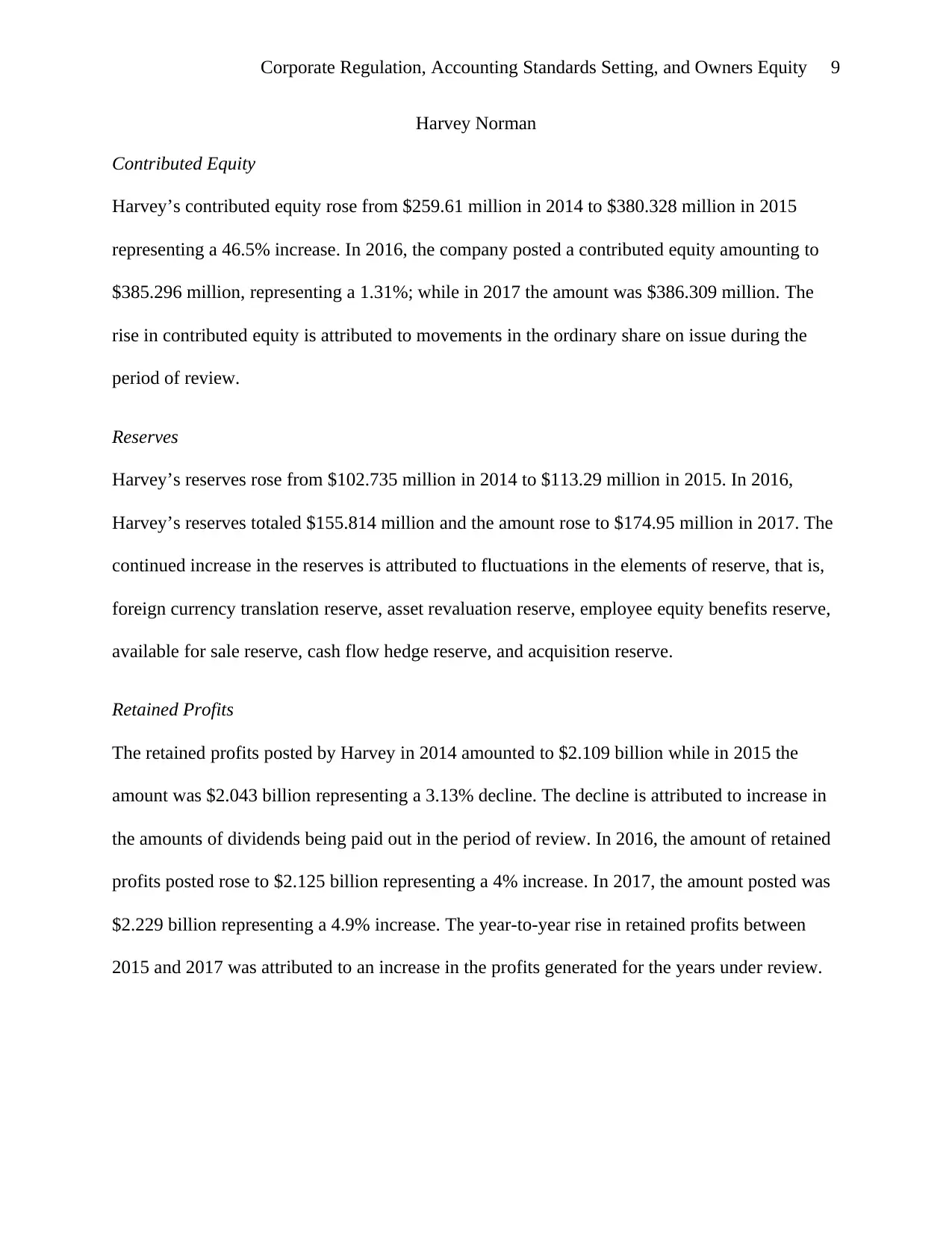
Corporate Regulation, Accounting Standards Setting, and Owners Equity 9
Harvey Norman
Contributed Equity
Harvey’s contributed equity rose from $259.61 million in 2014 to $380.328 million in 2015
representing a 46.5% increase. In 2016, the company posted a contributed equity amounting to
$385.296 million, representing a 1.31%; while in 2017 the amount was $386.309 million. The
rise in contributed equity is attributed to movements in the ordinary share on issue during the
period of review.
Reserves
Harvey’s reserves rose from $102.735 million in 2014 to $113.29 million in 2015. In 2016,
Harvey’s reserves totaled $155.814 million and the amount rose to $174.95 million in 2017. The
continued increase in the reserves is attributed to fluctuations in the elements of reserve, that is,
foreign currency translation reserve, asset revaluation reserve, employee equity benefits reserve,
available for sale reserve, cash flow hedge reserve, and acquisition reserve.
Retained Profits
The retained profits posted by Harvey in 2014 amounted to $2.109 billion while in 2015 the
amount was $2.043 billion representing a 3.13% decline. The decline is attributed to increase in
the amounts of dividends being paid out in the period of review. In 2016, the amount of retained
profits posted rose to $2.125 billion representing a 4% increase. In 2017, the amount posted was
$2.229 billion representing a 4.9% increase. The year-to-year rise in retained profits between
2015 and 2017 was attributed to an increase in the profits generated for the years under review.
Harvey Norman
Contributed Equity
Harvey’s contributed equity rose from $259.61 million in 2014 to $380.328 million in 2015
representing a 46.5% increase. In 2016, the company posted a contributed equity amounting to
$385.296 million, representing a 1.31%; while in 2017 the amount was $386.309 million. The
rise in contributed equity is attributed to movements in the ordinary share on issue during the
period of review.
Reserves
Harvey’s reserves rose from $102.735 million in 2014 to $113.29 million in 2015. In 2016,
Harvey’s reserves totaled $155.814 million and the amount rose to $174.95 million in 2017. The
continued increase in the reserves is attributed to fluctuations in the elements of reserve, that is,
foreign currency translation reserve, asset revaluation reserve, employee equity benefits reserve,
available for sale reserve, cash flow hedge reserve, and acquisition reserve.
Retained Profits
The retained profits posted by Harvey in 2014 amounted to $2.109 billion while in 2015 the
amount was $2.043 billion representing a 3.13% decline. The decline is attributed to increase in
the amounts of dividends being paid out in the period of review. In 2016, the amount of retained
profits posted rose to $2.125 billion representing a 4% increase. In 2017, the amount posted was
$2.229 billion representing a 4.9% increase. The year-to-year rise in retained profits between
2015 and 2017 was attributed to an increase in the profits generated for the years under review.
⊘ This is a preview!⊘
Do you want full access?
Subscribe today to unlock all pages.

Trusted by 1+ million students worldwide
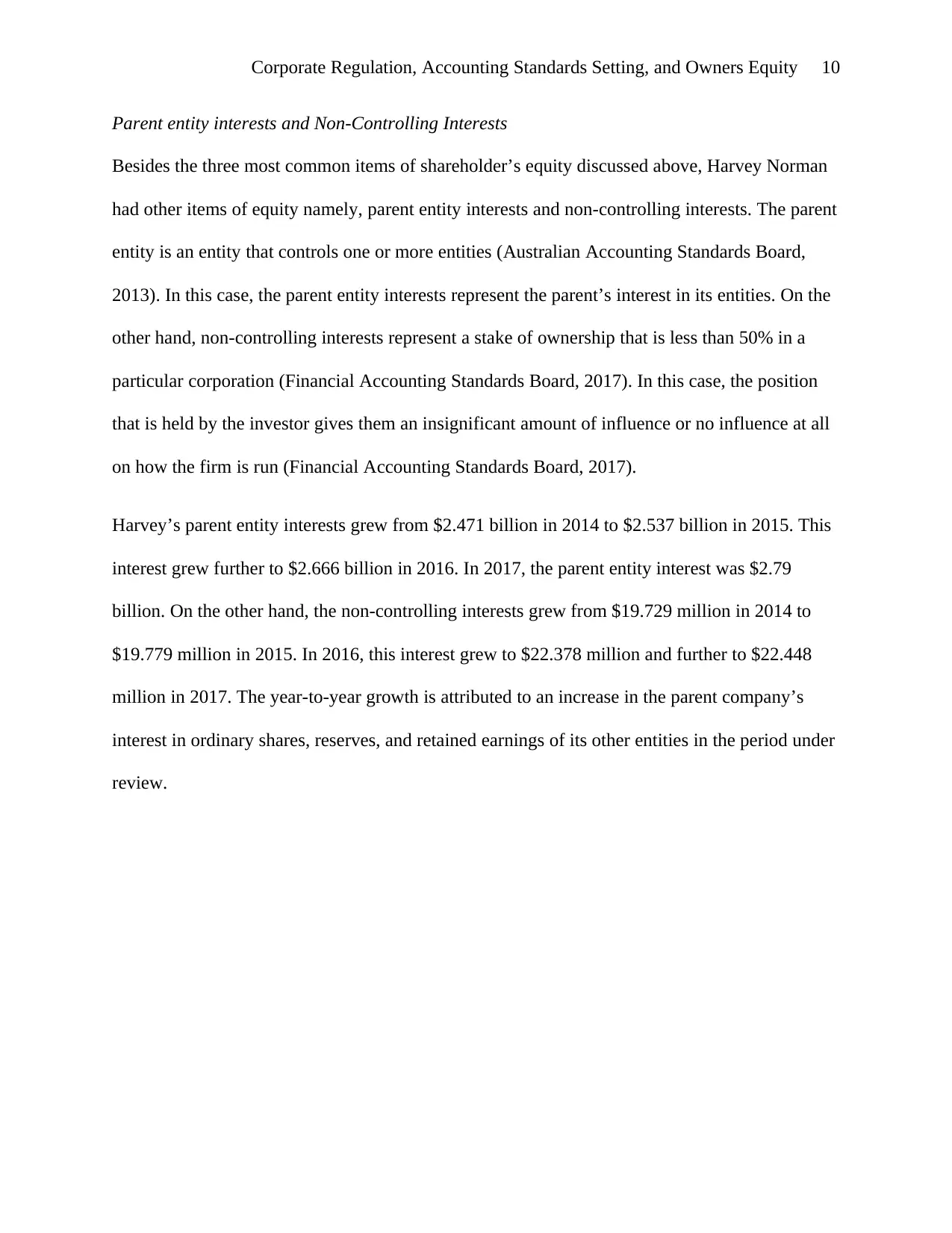
Corporate Regulation, Accounting Standards Setting, and Owners Equity 10
Parent entity interests and Non-Controlling Interests
Besides the three most common items of shareholder’s equity discussed above, Harvey Norman
had other items of equity namely, parent entity interests and non-controlling interests. The parent
entity is an entity that controls one or more entities (Australian Accounting Standards Board,
2013). In this case, the parent entity interests represent the parent’s interest in its entities. On the
other hand, non-controlling interests represent a stake of ownership that is less than 50% in a
particular corporation (Financial Accounting Standards Board, 2017). In this case, the position
that is held by the investor gives them an insignificant amount of influence or no influence at all
on how the firm is run (Financial Accounting Standards Board, 2017).
Harvey’s parent entity interests grew from $2.471 billion in 2014 to $2.537 billion in 2015. This
interest grew further to $2.666 billion in 2016. In 2017, the parent entity interest was $2.79
billion. On the other hand, the non-controlling interests grew from $19.729 million in 2014 to
$19.779 million in 2015. In 2016, this interest grew to $22.378 million and further to $22.448
million in 2017. The year-to-year growth is attributed to an increase in the parent company’s
interest in ordinary shares, reserves, and retained earnings of its other entities in the period under
review.
Parent entity interests and Non-Controlling Interests
Besides the three most common items of shareholder’s equity discussed above, Harvey Norman
had other items of equity namely, parent entity interests and non-controlling interests. The parent
entity is an entity that controls one or more entities (Australian Accounting Standards Board,
2013). In this case, the parent entity interests represent the parent’s interest in its entities. On the
other hand, non-controlling interests represent a stake of ownership that is less than 50% in a
particular corporation (Financial Accounting Standards Board, 2017). In this case, the position
that is held by the investor gives them an insignificant amount of influence or no influence at all
on how the firm is run (Financial Accounting Standards Board, 2017).
Harvey’s parent entity interests grew from $2.471 billion in 2014 to $2.537 billion in 2015. This
interest grew further to $2.666 billion in 2016. In 2017, the parent entity interest was $2.79
billion. On the other hand, the non-controlling interests grew from $19.729 million in 2014 to
$19.779 million in 2015. In 2016, this interest grew to $22.378 million and further to $22.448
million in 2017. The year-to-year growth is attributed to an increase in the parent company’s
interest in ordinary shares, reserves, and retained earnings of its other entities in the period under
review.
Paraphrase This Document
Need a fresh take? Get an instant paraphrase of this document with our AI Paraphraser
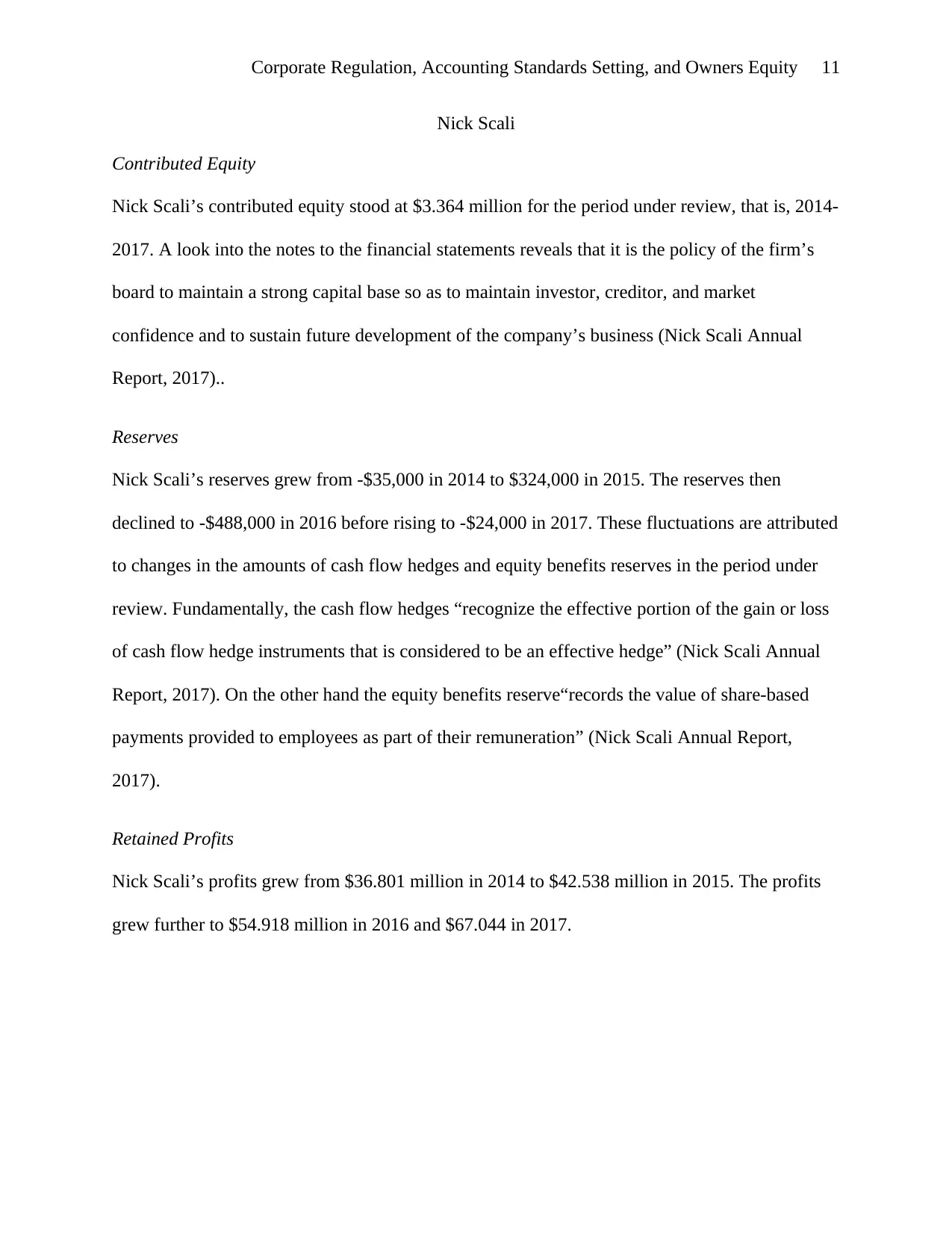
Corporate Regulation, Accounting Standards Setting, and Owners Equity 11
Nick Scali
Contributed Equity
Nick Scali’s contributed equity stood at $3.364 million for the period under review, that is, 2014-
2017. A look into the notes to the financial statements reveals that it is the policy of the firm’s
board to maintain a strong capital base so as to maintain investor, creditor, and market
confidence and to sustain future development of the company’s business (Nick Scali Annual
Report, 2017)..
Reserves
Nick Scali’s reserves grew from -$35,000 in 2014 to $324,000 in 2015. The reserves then
declined to -$488,000 in 2016 before rising to -$24,000 in 2017. These fluctuations are attributed
to changes in the amounts of cash flow hedges and equity benefits reserves in the period under
review. Fundamentally, the cash flow hedges “recognize the effective portion of the gain or loss
of cash flow hedge instruments that is considered to be an effective hedge” (Nick Scali Annual
Report, 2017). On the other hand the equity benefits reserve“records the value of share-based
payments provided to employees as part of their remuneration” (Nick Scali Annual Report,
2017).
Retained Profits
Nick Scali’s profits grew from $36.801 million in 2014 to $42.538 million in 2015. The profits
grew further to $54.918 million in 2016 and $67.044 in 2017.
Nick Scali
Contributed Equity
Nick Scali’s contributed equity stood at $3.364 million for the period under review, that is, 2014-
2017. A look into the notes to the financial statements reveals that it is the policy of the firm’s
board to maintain a strong capital base so as to maintain investor, creditor, and market
confidence and to sustain future development of the company’s business (Nick Scali Annual
Report, 2017)..
Reserves
Nick Scali’s reserves grew from -$35,000 in 2014 to $324,000 in 2015. The reserves then
declined to -$488,000 in 2016 before rising to -$24,000 in 2017. These fluctuations are attributed
to changes in the amounts of cash flow hedges and equity benefits reserves in the period under
review. Fundamentally, the cash flow hedges “recognize the effective portion of the gain or loss
of cash flow hedge instruments that is considered to be an effective hedge” (Nick Scali Annual
Report, 2017). On the other hand the equity benefits reserve“records the value of share-based
payments provided to employees as part of their remuneration” (Nick Scali Annual Report,
2017).
Retained Profits
Nick Scali’s profits grew from $36.801 million in 2014 to $42.538 million in 2015. The profits
grew further to $54.918 million in 2016 and $67.044 in 2017.
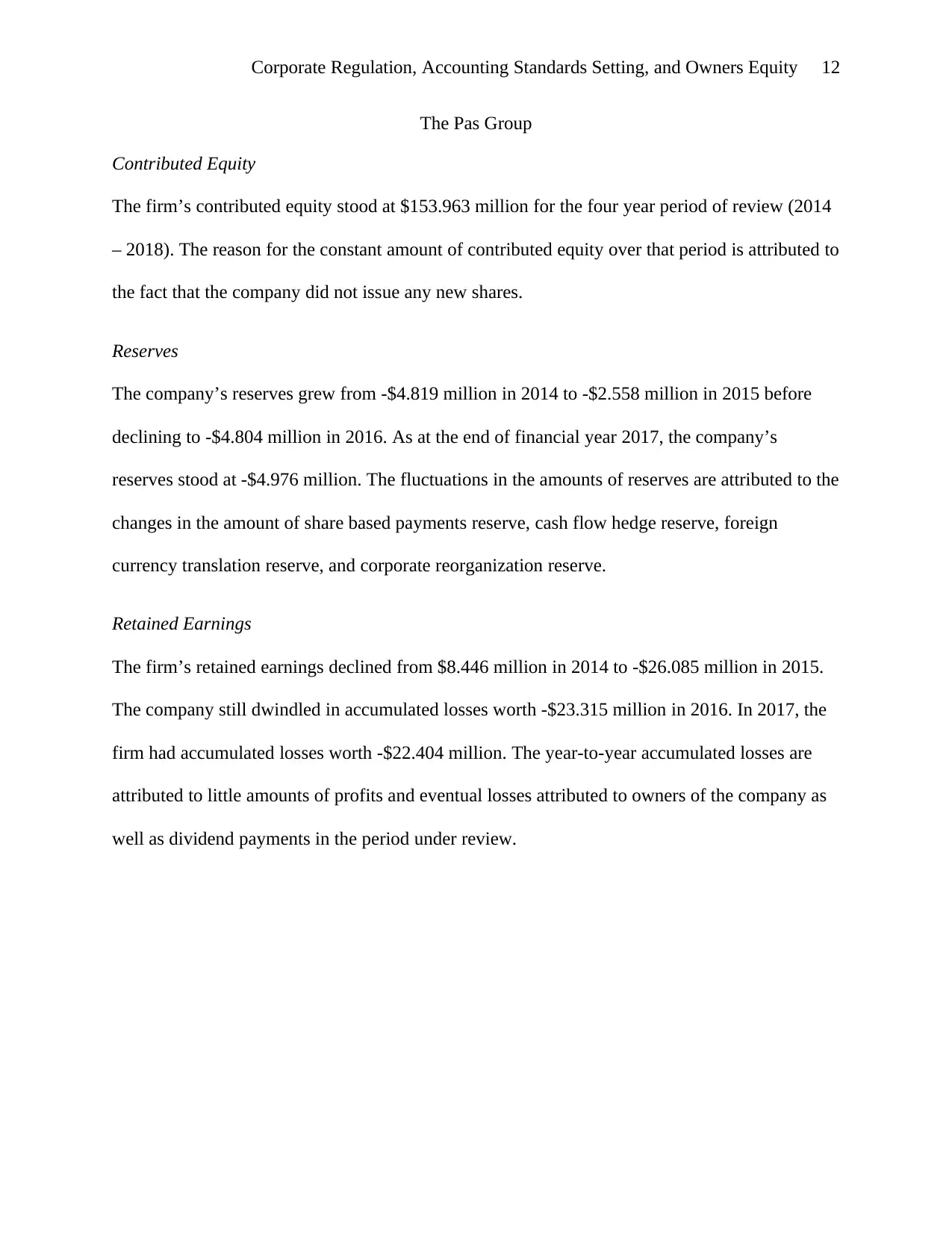
Corporate Regulation, Accounting Standards Setting, and Owners Equity 12
The Pas Group
Contributed Equity
The firm’s contributed equity stood at $153.963 million for the four year period of review (2014
– 2018). The reason for the constant amount of contributed equity over that period is attributed to
the fact that the company did not issue any new shares.
Reserves
The company’s reserves grew from -$4.819 million in 2014 to -$2.558 million in 2015 before
declining to -$4.804 million in 2016. As at the end of financial year 2017, the company’s
reserves stood at -$4.976 million. The fluctuations in the amounts of reserves are attributed to the
changes in the amount of share based payments reserve, cash flow hedge reserve, foreign
currency translation reserve, and corporate reorganization reserve.
Retained Earnings
The firm’s retained earnings declined from $8.446 million in 2014 to -$26.085 million in 2015.
The company still dwindled in accumulated losses worth -$23.315 million in 2016. In 2017, the
firm had accumulated losses worth -$22.404 million. The year-to-year accumulated losses are
attributed to little amounts of profits and eventual losses attributed to owners of the company as
well as dividend payments in the period under review.
The Pas Group
Contributed Equity
The firm’s contributed equity stood at $153.963 million for the four year period of review (2014
– 2018). The reason for the constant amount of contributed equity over that period is attributed to
the fact that the company did not issue any new shares.
Reserves
The company’s reserves grew from -$4.819 million in 2014 to -$2.558 million in 2015 before
declining to -$4.804 million in 2016. As at the end of financial year 2017, the company’s
reserves stood at -$4.976 million. The fluctuations in the amounts of reserves are attributed to the
changes in the amount of share based payments reserve, cash flow hedge reserve, foreign
currency translation reserve, and corporate reorganization reserve.
Retained Earnings
The firm’s retained earnings declined from $8.446 million in 2014 to -$26.085 million in 2015.
The company still dwindled in accumulated losses worth -$23.315 million in 2016. In 2017, the
firm had accumulated losses worth -$22.404 million. The year-to-year accumulated losses are
attributed to little amounts of profits and eventual losses attributed to owners of the company as
well as dividend payments in the period under review.
⊘ This is a preview!⊘
Do you want full access?
Subscribe today to unlock all pages.

Trusted by 1+ million students worldwide
1 out of 17
Related Documents
Your All-in-One AI-Powered Toolkit for Academic Success.
+13062052269
info@desklib.com
Available 24*7 on WhatsApp / Email
![[object Object]](/_next/static/media/star-bottom.7253800d.svg)
Unlock your academic potential
Copyright © 2020–2025 A2Z Services. All Rights Reserved. Developed and managed by ZUCOL.




